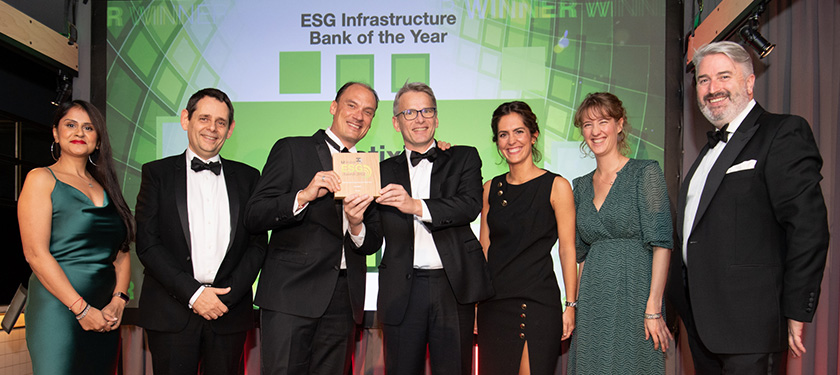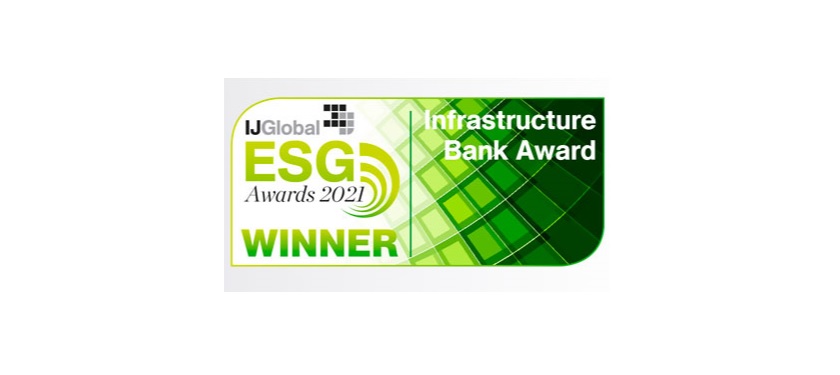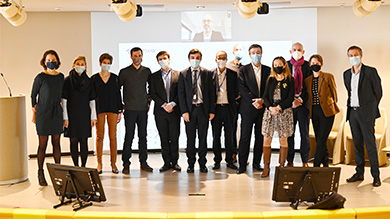Natixis has been named “ESG Infrastructure Bank of the Year” at the IJGlobal ESG Awards 2021, which identify organizations, transactions and individuals that have truly turned the dial on the environmental, social and governance front. This award applauds Natixis’ active efforts to roll out its ESG strategy over the last financial year – particularly in the infrastructure sector – and its major role in landmark ESG infrastructure financing deals and beyond its contribution to the development of a sustainable finance and banking market.
A leading role in “green” transactions
IJGlobal highlights Natixis’ strong commitment to leading major and innovative ESG transactions, in the renewables sector, where it rates third worldwide according to the latest IJGlobal ranking, but also in other infrastructure sub-sectors where it supports green projects such as data centers and district heating projects fueled by green power. The company also carefully monitors emerging sub-sectors with significant ESG impact, such as green hydrogen and carbon capture technologies.
Natixis offers green and sustainable financing products for both issuers and debt investors, with recent examples including its role as Sole Sustainability Structurer and Coordinator in NRG’s inaugural $900m Sustainability-Linked Bond (“SLB”). “This transaction represented many firsts”, explains Nasir Khan, Head of Infrastructure & Energy Finance for the Americas: “It was the first sustainability-linked bond from a North American issuer, the first sustainability-linked bond from a power company outside of Europe and the first sustainability-linked bond with a “most ambitious target” clause ensuring that any future bonds of this type from NRG will be of equal or greater climate ambition.” NRG followed this up with a second SLB in August 2021. The $1.1bn issuance was the first High Yield SLB within its sector outside Europe.
IJGlobal also underscores Natixis’ key role as Green Loan Coordinator for two landmark transactions: the $1.1 billion Climate Bonds Initiative-certified financing of The Geysers, a portfolio of 13 geothermal power plants in the US; and the £407m financing of the Kincardine Offshore Windfarm, a 50MW floating wind farm off the shore of Scotland, which is the largest floating offshore wind farm in the world, which is fully operational as of this week.
A diligent ESG strategy
One of the three pillars of the recently announced strategic plan for Natixis Corporate & Investment Banking is to be its clients’ “go-to financial partner” for their energy transition, and with this pledge in mind, the Infrastructure & Energy Finance Group fully embraces a diligent ESG strategy.
This expertise was reinforced when the infrastructure and energy departments were merged in 2020 with the aim of better supporting oil and gas sector clients in their energy transition. “This reorganization enables bankers who were specialized in fossil fuel energies to gain further insight into renewables and support their clients in their own transition”, explains Antoine Saint-Olive, Global Head of Infrastructure & Energy Finance Group, Natixis. “We broaden the transition dynamic beyond the energy sector and our approach beyond climate, to embrace social, natural resources and biodiversity trends”.
Natixis’ exacting approach also involves the exclusion of business sectors where borrowers do not comply with its requirements in terms of appetite for ESG-related risks, with exclusion lists set out for the coal, defense, tobacco, oil & gas sectors.
Meanwhile, the company’s Originate-to-Distribute model has accelerated the regular distribution of its financing commitments to non-banking financial institutions (NBFIs), which have stringent ESG requirements in their investment guidelines.
A leading “Green & Sustainable Finance House”
ESG permeates the company’s entire strategy and provides one of the three pillars of its new strategic plan. Since 2017, the ESR department has been tasked with a number of initiatives, including monitoring the bank’s ESR strategy and commitments, supervising its efforts to reduce its own carbon footprint and the impact of its business activities, and following its non-financial ratings.
Furthermore, Natixis Corporate & Investment Banking set up as early as in 2017 its Green & Sustainable Hub (GSH) with a view to coordinating the bank’s solutions and expertise on green and sustainable financing products across all asset classes in a unique centralized set up. This 25-strong team of experts covers a range of expertise, including green, social, transition, sustainability & sustainability-linked bonds/loans, climate/ESG indices and equity-linked green notes with many “first” and innovative transactions closed over the last few years.
Last but not least, Natixis also became the first bank to actively manage its balance sheet’s climate impact when it rolled out its Green Weighting Factor in 2019. This unprecedented mechanism allocates capital to financing deals based on their climate impact. Financing transactions are assigned an environmental rating on a seven-level color scale ranging from dark brown to dark green and receive a positive/negative adjustment in order to align the portfolio with a +2.5°C trajectory by 2024, +2.2°C by 2030 and +1.5°C by 2050, consistent with the goals set in the Paris Agreement.
All in all: “This award is also the recognition of the bank’s original set up where combined key expertise serves clients’ funding needs and their ability to report and leverage from their transition pathway” further notes Julien Duquenne, Co-Head of the Origination & Advisory, Green & Sustainable Hub EMEA.
An inspiring journey ahead
ESG issues are a source of vast opportunity and Natixis – and financial institutions as a whole – has a responsibility to draw on its expertise to develop renewable infrastructures and support its clients in their own transition, regardless of the sector and beyond the more visibly “green”. A challenging but inspiring journey lies ahead to a better world!
Watch the video with Antoine Saint-Olive, Global Head of Infrastructure & Energy Finance Group



















